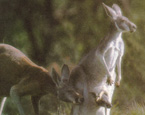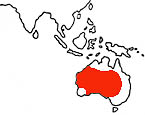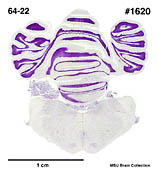|
Red
Kangaroo
(Macropus rufus) #64-22 |
MSU Red Kangaroo Brain Sections
|
Physical
characteristics and distribution
|
|
The Red Kangaroo is the largest living marsupial. It has a heavy frame, long legs and feet and a thick tail. The fur is short, thick and red or gray in color. Males range in total body length from 1,300 to 1,600 mm and females from 850 to 1,050 mm. Tail length is from 1,000 to 1,200 mm for males and 650 to 850 mm for females. They may weigh as much as 90 kg and may reach 1.8 meters in height when standing. Their
tail is strong enough to support the kangaroo's body weight,
acts as a balance when jumping, and is used, with the two legs,
to form a tripod for resting. The second and third toes of red
kangaroos are fused and shaped into a grooming claw. Their foreshortened
upper limbs terminate in clawed paws used with great dexterity
in eating, grooming, and self-defense. The
Red Kangaroo feeds on grass and green plants. They are found on mainland and mid-latitude Australia.
|
|
Description
of the brain
|
|
Animal
source and preparation
|
|
All
specimens collected followed the same preparation
and histological procedure.
|
Other
Related Resources (websites and publications)
List of Specimens | Explore Collections | Brain Sections | Brain Evolution | Brain Development | Brain Circuitry | Brain Functions | Location and Use | Related Web Sites | Contact Us | Search MSU Database | Personnel | Home



